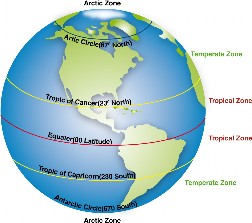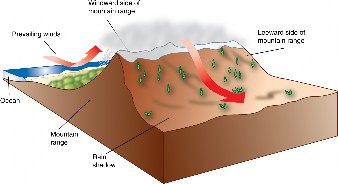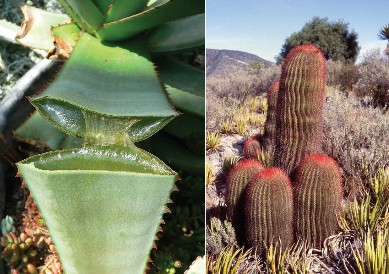Lesson 16.1: Biomes
Lesson 16.1: Biomes
Lesson Objectives
Define biome and climate, and explain how biomes are related to climate.
Outline how climate determines growing conditions for plants and affects the number and biodiversity of plants in a biome.
Explain how climate is related to biodiversity of biomes and adaptations of organisms.
Introduction
If you look at the two pictures in Figure 1 below, you will see very few similarities. The picture on the left shows a desert in Africa. The picture on the right shows a rainforest in Australia. What is the most obvious difference between the two places? It could be that the desert does not have any visible plants, whereas the rainforest is densely packed with trees. What causes these two places to be so different? The main reason is climate.
Biomes and Climate
The two pictures above represent two different types of biomes: deserts and rainforests. A biome is a group of similar ecosystems that cover a broad area. Biomes are major subdivisions of the biosphere. They can be classified into two major types:
Terrestrial biomes: biomes on land
Aquatic biomes: biomes in water

You will read about terrestrial biomes in Lesson 16.2 and aquatic biomes in Lesson 16.3. First, however, it is important to understand how climate influences biomes. Climate is the most important abiotic (non-living) factor affecting the distribution of terrestrial biomes of different types. Climate determines the growing conditions in an area, so it also determines what plants can grow there. Animals depend directly or indirectly on plants, so the type of animals that live in an area also depends on climate.
What Is Climate?
Climate is the average weather in an area over a long period of time, whereas weather is a day to day explanation. Weather and climate are described in terms of factors such as temperature and precipitation. The climate of a particular location depends, in turn, on its latitude (distance from the equator) and altitude (distance above sea level). Other factors that affect an area’s climate include its location relative to the ocean or mountain ranges. Temperature and moisture are the two climatic factors that most affect terrestrial biomes.
Temperature
In general, temperature on Earth’s surface falls from the equator to the poles. Based on temperature, climates can be classified as tropical, temperate, or arctic, as shown in Figure
Temperature also falls from lower to higher altitudes, for example, from the base of a
mountain to its peak. This explains why the tops of high mountains in tropical climates may be snow-capped year-round.
The ocean may also play an important role in the temperature of an area. Coastal areas may have milder climates than areas farther inland at the same latitude. This is because the temperature of the ocean changes relatively little from season to season, and this affects the temperature on nearby coasts. As a result, many coastal areas have both warmer winters and cooler summers than inland areas.

Moisture
Based on the amount of water available to plants, climates can be classified as arid (dry), semi-arid, semi-humid, or humid (wet). The moisture of a biome is determined by both precipitation and evaporation. Evaporation, in turn, depends on heat from the sun. World- wide precipitation patterns result from global movements of air masses and winds, which are shown in Figure 3. For example, warm, humid air masses rise over the equator and are moved north and south by global air currents. The air masses cool and cannot hold as much water. As a result, they drop their moisture as precipitation. This explains why many tropical areas receive more precipitation than other areas of the world.

When the same air masses descend at about 30° north or south latitude (see Figure 3), they are much drier. This explains why dry climates are found at these latitudes. These latitudes are also warm and sunny, which increases evaporation and dryness. Dry climates are found near the poles, as well. Extremely cold air can hold very little moisture, so precipitation is low in arctic zones. However, these climates also have little evaporation because of the extreme cold. As a result, cold climates with low precipitation may not be as dry as warm climates with the same amount of precipitation.
Distance from the ocean and mountain ranges also influences precipitation. For example, one side of a mountain range near the ocean may receive a lot of precipitation because warm, moist air masses regularly move in from the water. As air masses begin to rise up over the mountain range, they cool and drop their moisture as precipitation. This is illustrated in Figure 4.

By the time the air masses reach the other side of the mountain range, they no longer contain moisture. As a result, land on this side of the mountain range receives little precipitation. This land is in the rain shadow of the mountain range. Many inland areas far away from the ocean or mountain ranges are also dry. Air masses that have passed over a wide expanse of land to reach the interior of a continent usually no longer carry much moisture.
Climate and Plant Growth
Plants are the major producers in terrestrial biomes. Almost all other terrestrial organisms depend on them either directly or indirectly for food. Plants need air, warmth, sunlight, water, and nutrients to grow. Climate is the major factor affecting the number and diversity of plants that can grow in a terrestrial biome. Climate determines the average temperature and precipitation, the length of the growing season, and the quality of the soil, including levels of soil nutrients.
Growing Season
The growing season is the period of time each year when it is warm enough for plants to grow. The timing and length of the growing season determine what types of plants can grow in an area. For example, near the poles the growing season is very short. The temperature may rise above freezing for only a couple of months each year. Because of the cold temperatures and short growing season, trees and other slow-growing plants are unable to survive. The growing season gets longer from the poles to the equator. Near the equator, plants can grow year-round if they have enough moisture. A huge diversity of plants can grow in hot, wet climates.
The timing of precipitation also affects the growing season. In some areas, most of the precipitation falls during a single wet season (such as in California), rather than throughout the year (such as in New England). In these areas, the growing season lasts only as long as there is enough moisture for plants to grow.
Soil
Plants need soil that contains adequate nutrients and organic matter. Nutrients and organic matter are added to soil when plant litter and dead organisms decompose. In cold climates, decomposition occurs very slowly. As a result, soil in cold climates is thin and poor in nutrients. Soil is also thin and poor in hot, wet climates because the heat and humidity cause such rapid decomposition that little organic matter accumulates in the soil. The frequent rains also leach nutrients from the soil. Thin, poor soil is shown in the left drawing of Figure 5. The right drawing shows thick, rich soil. This type of soil is generally found in temperate climates and is best for most plants.
Biome Biodiversity and Adaptations
Because plants are the most important producers in terrestrial biomes, anything that affects their growth also influences the number and variety of other organisms that can be supported in a biome. Therefore, climate has a major impact on the biodiversity of biomes.
Biodiversity
Biodiversity refers to the number of different species of organisms in a biome (or ecosystem or other ecological unit). Biodiversity is usually greater in warmer biomes. Therefore, biodiversity generally decreases from the equator to the poles. Biodiversity is usually greater in wetter biomes, as well. Remember the desert and rainforest pictured in Figure 1? The biodiversity of these two biomes is vastly different. Both biomes have warm climates, but the desert is very dry, and the rainforest is very wet. The desert has very few organisms, so

it has low biodiversity. Some parts of the desert may have no organisms, and therefore zero biodiversity. In contrast, the rainforest has the highest biodiversity of any biome on Earth.
Adaptations
Plants, animals, and other organisms evolve adaptations to suit them to the abiotic factors in their biome. Abiotic factors to which they adapt include temperature, moisture, growing season, and soil. This is why the same type of biome in different parts of the world has organisms with similar adaptations. For example, biomes with dry climates worldwide have plants with similar adaptations to aridity, such as special tissues for storing water (see Figure 6).

In biomes with a severe cold or dry season, plants may become dormant during that season of the year. In dormant plants, cellular activities temporarily slow down, so the plants need less sunlight and water. For example, many trees shed their leaves and become dormant during very cold or dry seasons. Animals in very cold or dry biomes also must adapt to these abiotic factors. For example, adaptations to cold include fur or fat, which insulates the body and helps retain body heat.
Lesson Summary
A biome is a group of similar ecosystems that cover a broad area. Climate is the average weather in an area over a long period of time. Climate is the most important abiotic factor affecting the distribution of terrestrial biomes.
Climate includes temperature and precipitation, and it determines growing season and soil quality. It is the major factor affecting the number and diversity of plants in terrestrial biomes.
By affecting plants, which are the main producers, climate affects the biodiversity of terrestrial biomes. Plants and other organisms also evolve adaptations to climatic factors in their biomes, including adaptations to extreme cold and dryness.
Review Questions
Table 16.1:
City Latitude Altitude Location Temperature1
Seattle, Wash- ington
Denver, Col- orado
48°N 429 ft Coastal 33°F
41°N 5,183 ft Interior 15°F
Further Reading / Supplemental Links
Name three factors that help determine the climate of an ecosystem.
What is a rain shadow?
List some important factors related to climate that plants need in order to grow?
Compare the data for Seattle and Denver in the table below. What factors might explain why Seattle is warmer in the winter than Denver, even though Seattle is farther north?:
Average low temperature in January
Explain how the quality of soil in an area is influenced by climate.
Why is biodiversity higher at the equator than it is near the poles?
Harm J.de Blij, Peter O. Muller,and Richard S. Williams, Physical Geography: The Global Environment (3rd edition). Oxford University Press, 2004.
Ross E. Koning,Climate and Biomes, Plant Physiology Information Website.
Susan L. Woodward, Biomes of Earth: Terrestrial, Aquatic, and Human-Dominated. Greenwood Press, 2003.
http://estrellamountain.edu/faculty/farabee/biobk/BioBookcommecosys.html
http://ridge.icu.ac.jp/gen-ed/biomes.html
http://users.rcn.com/jkimball.ma.ultranet/BiologyPages/B/Biomes.html
Vocabulary
aquatic biome Biome in water.
biodiversity Number of different species of organisms in a biome (or ecosystem or other unit).
biome Group of similar ecosystems that cover a broad area.
climate Average weather in an area over a long period of time.
growing season Period of time each year when it is warm enough for plants to grow.
rain shadow Land on the leeward side of a mountain range that receives very little pre- cipitation.
terrestrial biome Biome on land.
Points to Consider
Plants and the other organisms in terrestrial biomes are greatly influenced by climate.
What is the climate like where you live?
How hot or cold does it get, and how much precipitation usually falls?
Discuss with your class the climate in your area and how it seems to affect plant growth.
What plants and animals are naturally found in your part of the country?
- Log in or register to post comments
- Email this page
